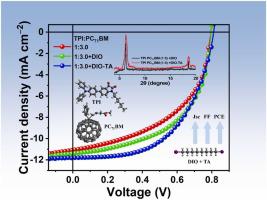当前位置:
X-MOL 学术
›
Synth. Met.
›
论文详情
Our official English website, www.x-mol.net, welcomes your feedback! (Note: you will need to create a separate account there.)
Synergistic strategies to unveil the dual influence of additive and annealing treatment on the morphology of isatin-derived low bandgap small molecule donor in solution-processed organic solar cells
Synthetic Metals ( IF 4.0 ) Pub Date : 2024-04-10 , DOI: 10.1016/j.synthmet.2024.117619 Abdullah , Sei-Jin Lee , Jong-Bae Park , Yang-Soo Kim , Ashique Kotta , Hyung-Kee Seo
Synthetic Metals ( IF 4.0 ) Pub Date : 2024-04-10 , DOI: 10.1016/j.synthmet.2024.117619 Abdullah , Sei-Jin Lee , Jong-Bae Park , Yang-Soo Kim , Ashique Kotta , Hyung-Kee Seo

|
A novel organic small molecule, 5-(4-(diphenylamino)phenyl)-1-octylindoline-2,3-dione (TPI) containing an alkyl chain substituted electron accepting isatin (indoline-2,3-dione) and strong electron withdrawing N, N-diphenylaniline units have been synthesized through Suzuki coupling reaction. The molecular structure of TPI is confirmed by NMR, FT-IR, and Mass spectroscopy techniques. The TPI molecule exhibits a low band gap of approximately ∼ 2.03 eV which is also supported by the DFT results. The influence of additive and heat treatment on the electronic, morphological, and photovoltaic performance of organic solar cells was investigated meticulously. The TPI donor exhibits complementary light absorption with fullerene acceptor in combination with DIO and TA which efficiently absorb the photon in the 300–730 nm range. The TPI was later used as an electron donor material for the fabrication of organic solar cells. Remarkably, the morphology-dependent optimized TPI:PCBM (1:3.0) exposed excellent power conversion efficiency (PCE) of about ∼ 5.56 % with enhanced V of ∼ 0.811 V, J of 11.81 mA cm and FF of 55.3 % fabricated in addition with DIO and thermal annealing treatment. Most importantly, the unencapsulated devices maintained > 96 % of the initial PCE value after 240 h under ambient temperature. Our findings indicate that isatin-derived small molecules with simple architecture propose great potential for promising BHJ-OSCs material.
中文翻译:

协同策略揭示添加剂和退火处理对溶液加工有机太阳能电池中靛红衍生的低带隙小分子供体形态的双重影响
一种新型有机小分子,5-(4-(二苯氨基)苯基)-1-辛基吲哚啉-2,3-二酮(TPI),含有烷基链取代的电子接受靛红(吲哚啉-2,3-二酮)和强吸电子性通过Suzuki偶联反应合成了N,N-二苯基苯胺单元。 TPI 的分子结构通过 NMR、FT-IR 和质谱技术得到证实。 TPI 分子表现出约 ∼2.03eV 的低带隙,DFT 结果也支持这一点。仔细研究了添加剂和热处理对有机太阳能电池的电子、形态和光伏性能的影响。 TPI 供体与富勒烯受体结合 DIO 和 TA 表现出互补的光吸收,可有效吸收 300-730 nm 范围内的光子。 TPI 后来被用作制造有机太阳能电池的电子供体材料。值得注意的是,形态相关的优化 TPI:PCBM (1:3.0) 表现出优异的功率转换效率 (PCE),约为 ∼5.56%,增强的 V 为 ∼0.811V,J 为 11.81mAcm,FF 为 55.3%,此外还采用DIO和热退火处理。最重要的是,未封装的器件在环境温度下 240 小时后仍保持初始 PCE 值的 96% 以上。我们的研究结果表明,具有简单结构的靛红衍生小分子为有前景的 BHJ-OSC 材料提供了巨大的潜力。
更新日期:2024-04-10
中文翻译:

协同策略揭示添加剂和退火处理对溶液加工有机太阳能电池中靛红衍生的低带隙小分子供体形态的双重影响
一种新型有机小分子,5-(4-(二苯氨基)苯基)-1-辛基吲哚啉-2,3-二酮(TPI),含有烷基链取代的电子接受靛红(吲哚啉-2,3-二酮)和强吸电子性通过Suzuki偶联反应合成了N,N-二苯基苯胺单元。 TPI 的分子结构通过 NMR、FT-IR 和质谱技术得到证实。 TPI 分子表现出约 ∼2.03eV 的低带隙,DFT 结果也支持这一点。仔细研究了添加剂和热处理对有机太阳能电池的电子、形态和光伏性能的影响。 TPI 供体与富勒烯受体结合 DIO 和 TA 表现出互补的光吸收,可有效吸收 300-730 nm 范围内的光子。 TPI 后来被用作制造有机太阳能电池的电子供体材料。值得注意的是,形态相关的优化 TPI:PCBM (1:3.0) 表现出优异的功率转换效率 (PCE),约为 ∼5.56%,增强的 V 为 ∼0.811V,J 为 11.81mAcm,FF 为 55.3%,此外还采用DIO和热退火处理。最重要的是,未封装的器件在环境温度下 240 小时后仍保持初始 PCE 值的 96% 以上。我们的研究结果表明,具有简单结构的靛红衍生小分子为有前景的 BHJ-OSC 材料提供了巨大的潜力。











































 京公网安备 11010802027423号
京公网安备 11010802027423号